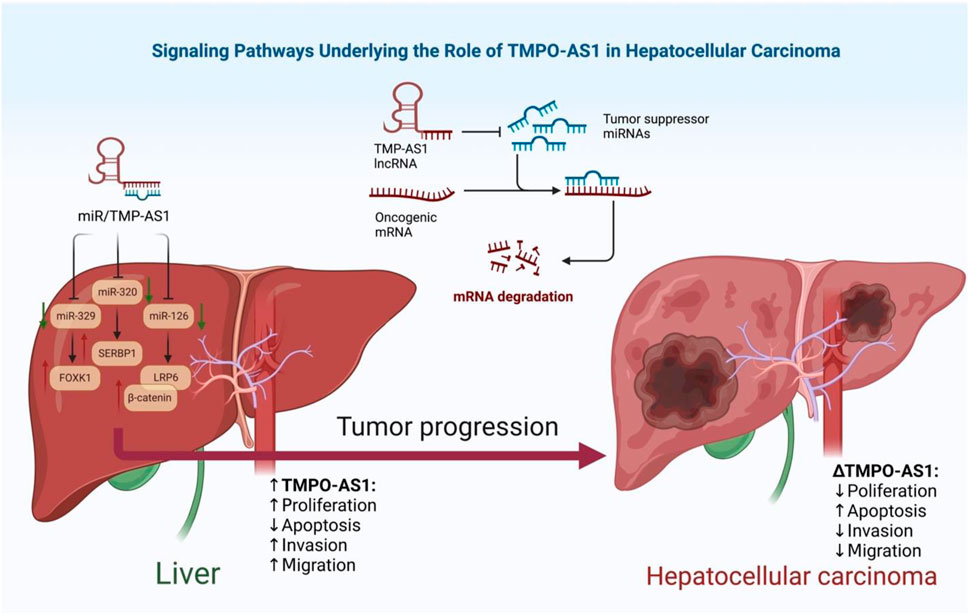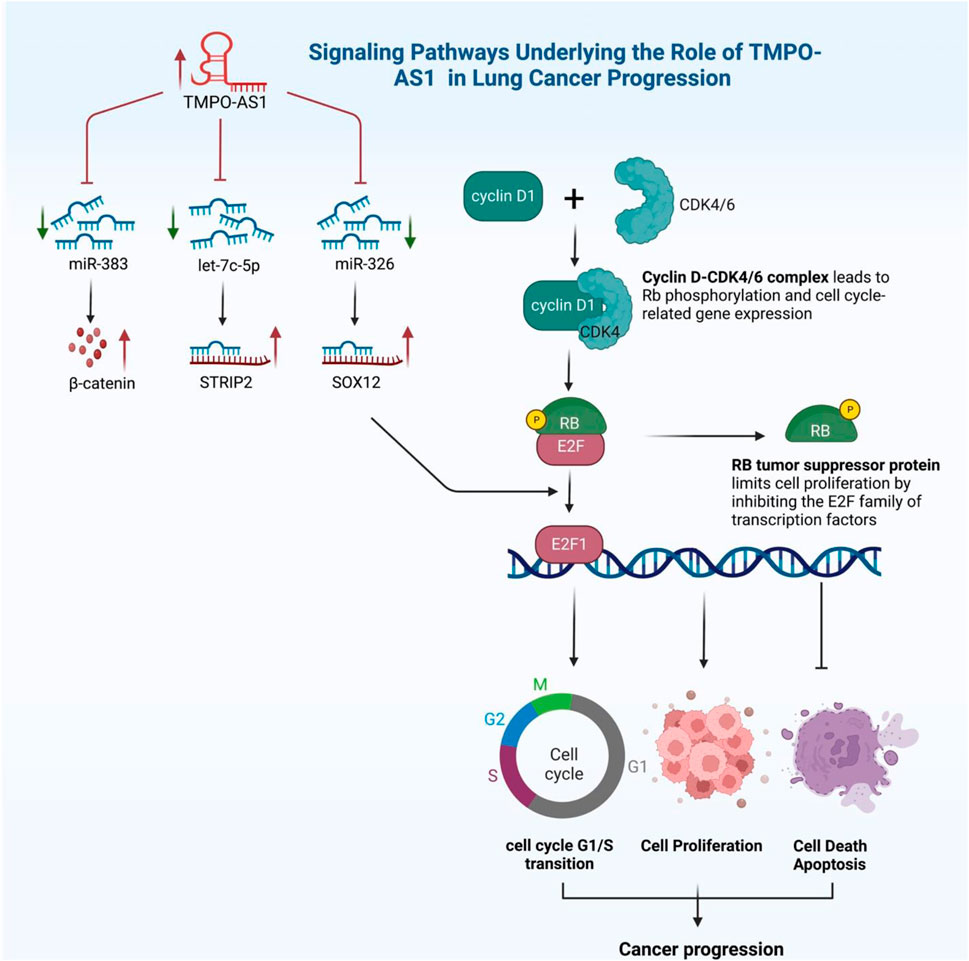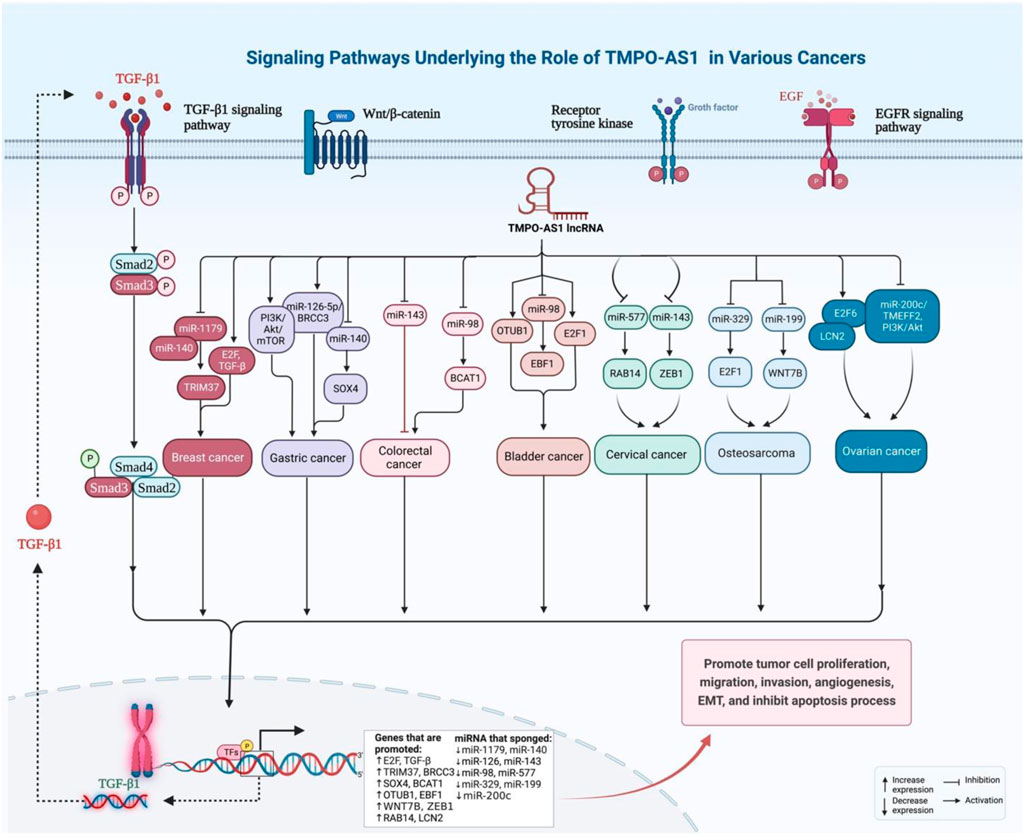- 1Department of Medical Genetics, Shahid Beheshti University of Medical Sciences, Tehran, Iran
- 2Phytochemistry Research Center, Shahid Beheshti University of Medical Sciences, Tehran, Iran
- 3Department of Pharmacognosy, College of Pharmacy, Hawler Medical University, Erbil, Iraq
- 4Center of Research and Strategic Studies, Lebanese French University, Erbil, Iraq
- 5Urology and Nephrology Research Center, Shahid Beheshti University of Medical Sciences, Tehran, Iran
- 6Institute of Human Genetics, Jena University Hospital, Jena, Germany
- 7Skull Base Research Center, Loghman Hakam Hospital, Shahid Beheshti University of Medical Sciences, Tehran, Iran
Long non-coding RNAs are demonstrated to contribute to carcinogenesis. TMPO Antisense RNA 1 (TMPO-AS1) is an example of lncRNAs with crucial roles in this process. This lncRNA serves as a sponge for miR-320a, miR-383-5p, miR-329-3p, miR-126, miR-329, miR-199a-5p, miR-577, miR-4731-5p, miR-140-5p, miR-1179, miR-143-3p, miR-326, miR-383-5p, let-7c-5p, let-7g-5p, miR-199a-5p, miR-200c, miR-204-3p, miR-126-5p, miR-383-5p, miR-498, miR-143-3p, miR-98-5p, miR-140 and miR-143. It can also affect activity of PI3K/Akt/mTOR pathway. The current review summarizes the role of TMPO-AS1 in the carcinogenesis and assessment of its potential as a marker for certain types of cancers.
Introduction
Long non-coding RNAs (lncRNAs) are a class of RNAs with sizes more than 200 nt and some similar features with mRNAs, yet they do not encode large polypeptides. These transcripts have critical functions in the embryonic development (Kung et al., 2013), DNA damage response (Thapar, 2018; Ghafouri-Fard et al., 2021) and carcinogenic processes (Schmitt and Chang, 2017; Ghafouri-Fard et al., 2020). Based on the latest reports from GENCODE and FANTOM projects, there are approximately 18,000 and 28,000 lncRNA genes, respectively (Hon et al., 2017; Frankish et al., 2019). The role of these transcripts in the development of human disorders, particularly cancers is being elucidated in recent years. The vast majority of investigations are focused on identification of the impact of lncRNAs in the development of cancers, since cancers constitute a major cause of mortality. In fact, lncRNAs can affect all features of cancer development, including cell proliferation/differentiation, cell cycle transition, metastatic ability and invasiveness of cancer cells, epithelial-mesenchymal transition (EMT) and angiogenesis (Ghaforui-Fard et al., 2019; Ghafouri-Fard and Taheri, 2019).
TMPO Antisense RNA 1 (TMPO-AS1) is an example of lncRNAs with crucial roles in the carcinogenesis. Genomic location for this lncRNA is chr12:98,510,417–98,516,454 (GRCh38/hg38), minus strand. Expression of this lncRNA has been appraised in numerous types of cancers, revealing its important roles in the oncogenesis. The current review aims at identification of the impact of TMPO-AS1 in the carcinogenesis and evaluation of its potential as a marker for certain types of cancers.
Cell line studies
TMPO-AS1 has been noticeably upregulated in nasopharyngeal cancer cells. TMPO-AS1 silencing has restrained aggressive behaviors of these cells, while its over-expression has led to the opposite results. Mechansitically, TMPO-AS1 acts as a molecular sponge for miR-320a, leading to up-regulation of the mRNA target of miR-320a, i.e. SOX4. Taken together, TMPO-AS1/miR-320a/SOX4 axis has been shown to enhance progression of nasopharyngeal carcinoma (Xing et al., 2021).
This lncRNA has also been shown to be up-regulated in bladder cell lines and facilitate cell growth. Moreover, TMPO-AS1 could boost migration and invasive features of bladder cancer cells. Expression of TMPO-AS1 has been found to be induced by EBF transcription factor 1 (EBF1). This cytoplasmic lncRNA serves as a sponge for miR-98-5p. EBF1 has been verified to be a target of miR-98-5p whose expression is negatively correlated with expression of miR-98-5p. EBF1 up-regulation restores the suppressive role of TMPO-AS1 silencing in the development of bladder cancer (Luo et al., 2020). Another study in bladder cancer has confirmed the role of TMPO-AS1 in enhancement of cell proliferation, migratory potential, and invasion and suppression of cell. Mechanical studies have also shown that E2F1 up-regulates TMPO-AS1. In addition, TMPO-AS1 has been found to facilitate the interaction between E2F1 and OTUB1. This interaction leads to deubiquitination of E2F1 and its stabilization facilitating the role of TMPO-AS1 in induction of malignant phenotypes in bladder cancer. Further studies have confirmed that TMPO-AS1 induces growth of bladder cancer through an E2F1-dependent manner. This study has verified the importance of a TMPO-AS1/E2F1 positive regulatory circuit in the development of bladder cancer (Zhang et al., 2021).
TMPO-AS1 has also up-regulated in glioma cell lines parallel with down-regulation of miR-383-5p. TMPO-AS1 silencing has intimidated proliferation, migration and invasive abilities of glioma cells. Further experiments have shown that miR-383-5p is a target of TMPO-AS1 (Liu et al., 2020a).
Expression of TMPO-AS1 has also been elevated in hepatocellular carcinoma cell lines. TMPO-AS1 silencing has suppressed viability, migration aptitude and invasiveness of these cells. This lncRNA has mainly located in the cytoplasm of hepatocellular carcinoma cells, where it sponges miR-320a and facilitates up-regulation of SERBP1 (Wang et al., 2020). Another study in this type of cancer has shown that TMPO-AS1 boosts both proliferation and EMT through targeting the miR-126-3p/LRP6/β-catenin axis (Huang et al., 2021) (Figure 1).
In osteosarcoma cells, TMPO-AS1/miR-329/E2F1 axis has been acknowledged as an imporatnt regulator of cell proliferation and apoptosis. Inhibition of TMPO-AS1, overexpression of miR-329 and inhibition of E2F1 could defeat proliferation and invasiveness of osteosarcoma cells and enhance their apoptosis. Moreover, TMPO-AS1 could regulate EMT process in osteosarcoma cells via the mentioned axis (Liu et al., 2020b). Another study in this type of cancer has revealed the importance of TMPO-AS1/miR-199a-5p/WNT7B axis in the enhancemnet of tumorigenic properties (Cui and Zhao, 2020).
Likewise, Wei and his colleagues showed that E2F1-regulate TMPO-AS1 lncRNA affects lung cancer cell proliferation through controlling the miR-326/SOX12 pathway (Wei et al., 2020). They revealed that advanced clinical stage and poor prognosis in Lung adenocarcinoma (LUAD) were linked to increased TMPO-AS1 expression. Furthermore, reducing TMPO-AS1 expression could slow LUAD cell growth by stopping the cell cycle at the G0/G1 stage and triggering apoptosis. Similarly, Li et al. reported that inhibiting TMPO-AS1 through the miR-143-3p/CDK1 pathway causes increasing apoptosis process in Lung cancer cells (Li et al., 2021) (Figure 2).
Meanwhile, TMPO-AS1/miR-577/RAB14 (Yang et al., 2019) and TMPO-AS1/miR-143-3p/ZEB1 (Gang et al., 2020) axes have been identified as important regulator of malignnat phenotyps of cervical cancer cells.
In breast cancer cell lines, TMPO-AS1 has been found to sponge for miR-4731-5p (Wang et al., 2021), miR-140-5p (Zhu et al., 2021) and miR-1179 (Ning et al., 2021) and up-regulate oncogenic targets of these miRNAs. Besides, TMPO-AS1 has been found to be over-expressed in endocrine therapy-resistant MCF-7 cells compared with estrogen inducible parental cells. Mechanistically, TMPO-AS1 enhances proliferative ability and viability of estrogen receptor (ESR)-positive breast cancer cells. Moreover, expression of this lncRNA is linked with the estrogen signaling cascade. TMPO-AS1 can also up-regulate expression of ESR1 through stabilizing its transcripts. Up-regulation of ESR1 transcript by this lncRNA has a crucial impact in the proliferation of ESR-positive breast cancer (Mitobe et al., 2019).
In prostate cancer cells, TMPO-AS1 is mainly localized in the cytoplasm and directly down-regulated by androgen receptor. Up-regulation of TMPO-AS1 could increase cell proliferation through enhancing cell cycle progression (Huang et al., 2018) (Table 1). Figure 3 shows the expression pattern, targets and effects of TMPO-AS1 dysregulation in different types of cancer cells.
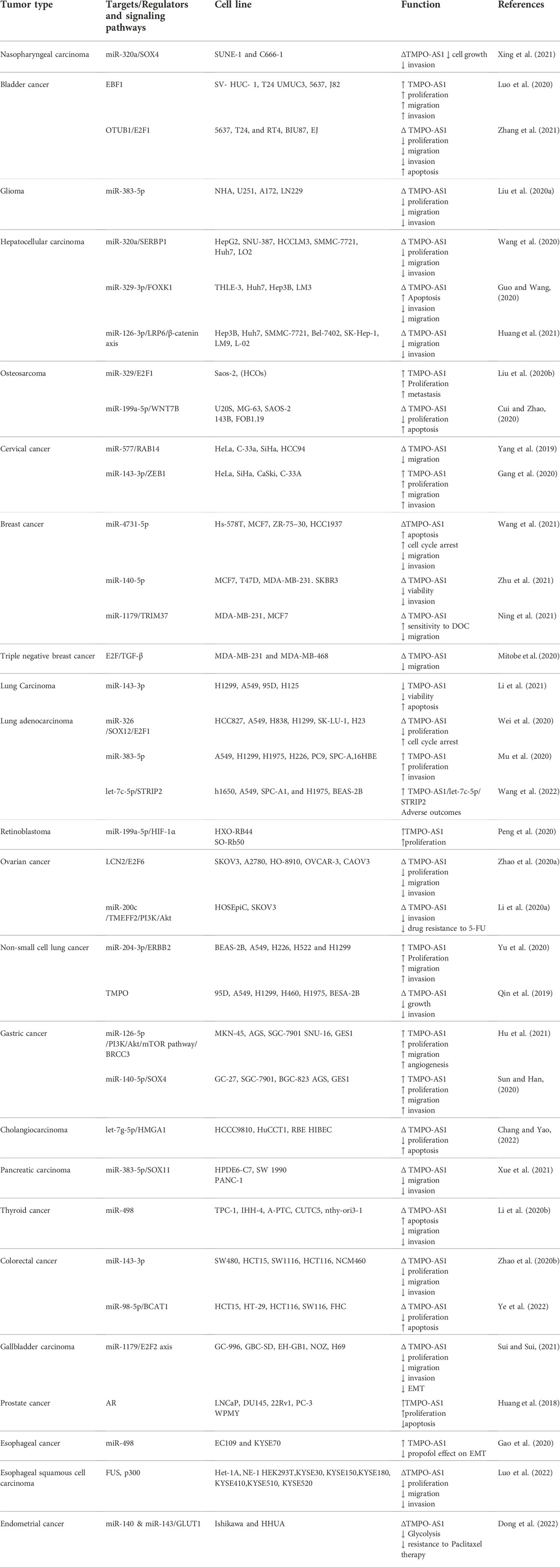
TABLE 1. Expression pattern of TMPO-AS1 in cancer cell lines (Δ: knock-down or deletion, DOC: docetaxel).
Animal studies
Results of studies in xenograft models of different cancer consistently support the oncogenic role of TMPO-AS1 (Table 2). All studies have confirmed that TMPO-AS1 silencing results in reduction of tumor burden in animal models. A single study in xenograft model of nasopharyngeal carcinoma SUNE1 cells has also verified the inhibitory effect of TMPO-AS1 knockdown on nasopharyngeal carcinoma cells growth. A notable reduction has been observed in tumor volume in the mice group injected with sh-TMPO-AS1. Based on the immunohistochemistry staining and qRT-PCR assays, substantial suppression in the expression of SOX4 and significant increase in miR-320a expression have been observed in mice injected with sh-TMPO-AS1-transfected cells. In vivo rescue experiments have also confirmed the sponging effect of TMPO-AS1 on miR-320a. miR-320a mimics-transfected SNUE1 cells have exhibited lower in vivo growth. Besides, TMPO-AS1 over-expression has reduced miR-320a levels in tumor tissues elevated by miR-320a mimics transfection (Xing et al., 2021).
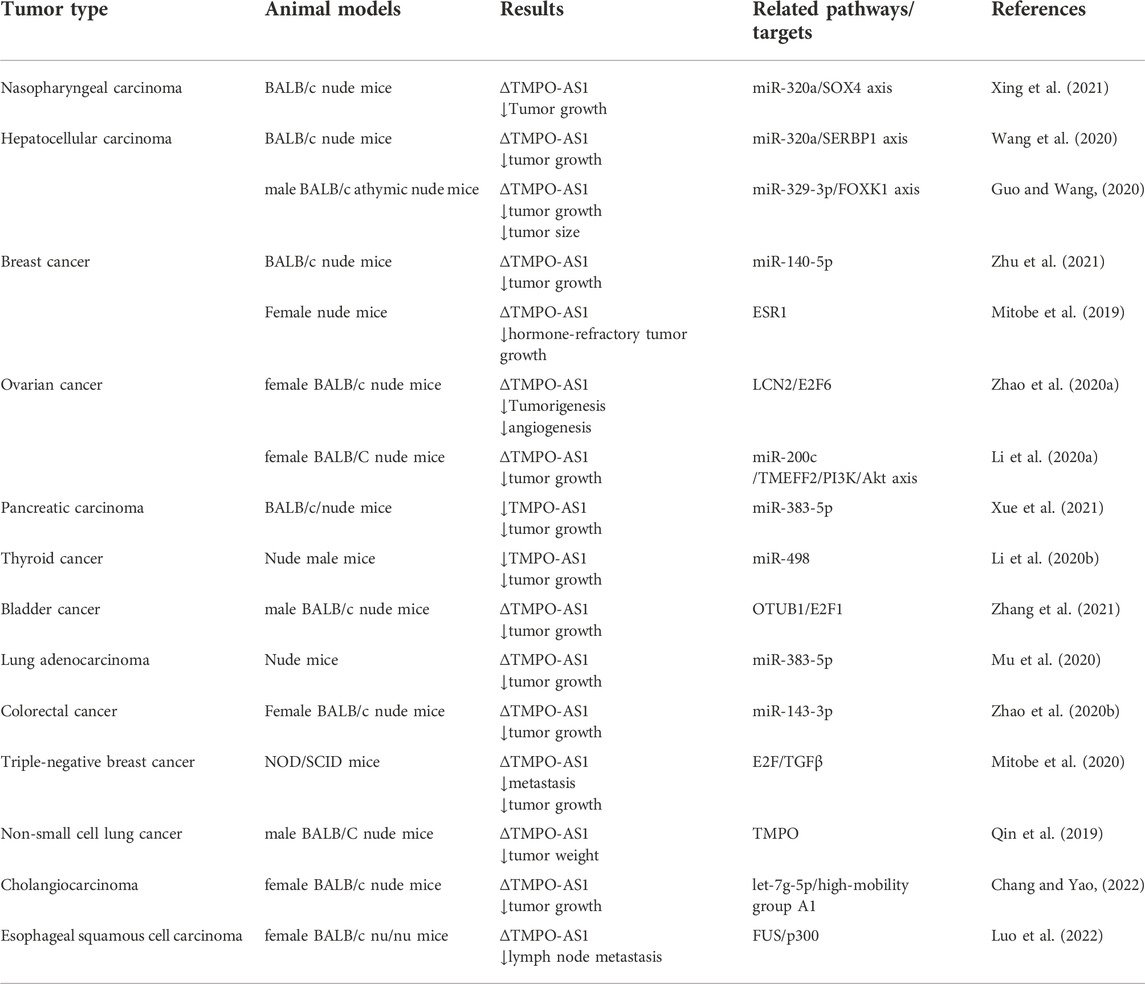
TABLE 2. Influence of TMPO-AS1 in carcinogenesis based on studies in animal models (NOD-SCID: non-obese diabetic/severe combined immunodeficiency, Δ: knock-down or deletion).
Inoculation of stably transfected RT4 bladder cancer cells into nude mice has also verified that TMPO-AS1 can enhance bladder cancer growth through E2F1 in vivo. TMPO-AS1 silencing has substantially suppressed tumor growth, while up-regulation of E2F1 has eliminated the inhibitory effects on tumor growth resulted from TMPO-AS1 silencing. Besides, the immunohistochemistry staining has shown that TMPO-AS1 silencing results in a considerable reduction in Ki-67 and E2F1 levels and a prominent increase in caspase-3 expression (Zhang et al., 2021). Additionally, TMPO-AS1 has been shown to enhance proliferative ability and viability of ESR-positive breast cancer cells in animal models (Mitobe et al., 2019). Moreover, its silencing can decrease hormone-refractory tumor growth (Mitobe et al., 2019). In addition, experiments in animal models of ovarian cancer have confirmed a significant decrease in the angiogenic potential following TMPO-AS1 silencing (Zhao et al., 2020a). Finally, in animal models of esophageal squamous cell carcinoma, TMPO-AS1 silencing can suppress lymph node metastasis (Luo et al., 2022).
Studies in clinical samples
Expression of TMPO-AS1 has been found to be elevated in all kinds of examined cancerous clinical samples (Table 3). In hepatocellular carcinoma samples, over-expression of TMPO-AS1 has been related to advanced stages and worse prognosis (Wang et al., 2020). Over-expression of TMPO-AS1 has also been related to large tumor size, lymphatic metastasis, and advanced stage in another study on patients with hepatocellular carcinoma (Guo and Wang, 2020). Meanwhile, portal vein tumor thrombosis has been another feature that has been associated with up-regulation of this lncRNA in hepatocellular carcinoma (Huang et al., 2021). In silico analysis of TCGA database and expression assays in clinical specimens of bladder cancer have confirmed up-regulation of TMPO-AS1 in bladder cancer tissues compared with normal bladder samples. Notably, worse survival has been reported for patients with over-expression of this lncRNA. Moreover, up-regulation of TMPO-AS1 has been correlated with muscle invasiveness and advance TNM stage in these patients (He et al., 2020). RNA-sequencing data of breast cancer samples has shown correlation between TMPO-AS1 level and proliferative biomarkers. Moreover, TMPO-AS1 positivity has been significantly correlated with poor prognosis of patients with this type of cancer (Mitobe et al., 2019). TMPO-AS1 has also been suggested to be a valuable diagnostic and prognostic marker for prostate cancer, since its up-regulation has been associated with poorer prognosis of patients with prostate cancer. In silico studies have predicated associations between TMPO-AS1 and a number of biological processes participating in the progression of prostate cancer (Huang et al., 2018). Similar to other types of cancer, up-regulation of TMPO-AS1 has been associated with lymph node involvement and distant metastasis in patients with colorectal cancer (Mohammadrezakhani et al., 2020).

TABLE 3. Dysregulation of TMPO-AS1 or other genes that interact with TMPO-AS1 in clinical specimens (PANTs: paired adjacent normal tissues, OS: overall survival, LNM: lymph node metastasis, BCR: biochemical recurrence).
Diagnostic role of TMPO-AS1 has been assessed in osteosarcoma and colorectal cancer, yielding better performance in the former type of cancer (Table 4).
Concluding remarks
TMPO-AS1 is an lncRNA with crucial roles in the carcinogenic processes. The best appreciated route of participation of TMPO-AS1 in these processes is its function as a molecular sponge for miRNAs. This lncRNA serves as a sponge for miR-383-5p, miR-320a, miR-329-3p, miR-126, miR-329, miR-199a-5p, miR-577, miR-4731-5p, miR-140-5p, miR-1179, miR-143-3p, miR-326, miR-383-5p, let-7c-5p, let-7g-5p, miR-199a-5p, miR-200c, miR-204-3p, miR-126-5p, miR-383-5p, miR-498, miR-143-3p, miR-98-5p, miR-140 and miR-143. Most of these miRNAs have anti-cancer effects through modulation of cell apoptosis, survival and differentiation. Thus, TMPO-AS1 has several routes of actions. Each of TMPO-AS1/miRNA axes has the potential to be used as diagnostic marker or therapeutic target. However, those being dysregulated in more than on type of cancer seem to be more appropriate, since they can be used in different types of cancers. Moreover, TMPO-AS1/miRNA/mRNA axes having specific roles in a certain type of cancer can be used for diagnostic marker for this type of cancer, particularly in the follow-up of patients after conduction of therapeutic modalities.
Several studies have reported regulatory role of TMPO-AS1 on PI3K/Akt/mTOR pathway. Based on the importance of this pathway in cancer progression and availability of targeted therapies against this pathway (Alzahrani, 2019), therapeutic modalities that affect expression of TMPO-AS1 are promising strategies for enhancement of the effects of PI3K/Akt/mTOR-targeting modalities.
Although dysregulation of TMPO-AS1 has been described in several cancers, diagnostic role of this lncRNA has only been assessed in two types of cancerous tissues versus non-cancerous tissues. Moreover, its application as a diagnostic marker in the peripheral blood has not been evaluated. Since assessment of expression profile of lncRNAs in the peripheral blood can facilitate identification of novel strategies for non-invasive detection of malignant conditions, further studies should evaluate expression of TMPO-AS1 in different stages of cancer progression to find its potential as early diagnostic marker and its relevance with progression of cancer. Based on the heterogeneity of expression profiles in the cancerous samples, a more applicable strategy is identification of panels of lncRNAs which can discriminate cancer patients from healthy controls with higher efficacy.
Several experiments have shown that TMPO-AS1 silencing can attenuate malignant behavior of cancer cells in cultures and in xenograft models of cancer. Thus, TMPO-AS1-targeting strategies have the potential to be used as therapeutic modalities for cancer treatment. Therefore, future investigations should find effective methods for specific delivery of anti-TMPO-AS1 modalities to cancer cells and evaluate their safety and efficacy in suppression of tumor growth in clinical settings.
Finally, preliminary studies have shown that TMPO-AS1 silencing can enhance sensitivity to paclitaxel (Dong et al., 2022) and docetaxel (Ning et al., 2021) in endometrial and breast cancers, respectively. Thus, targeted therapies against this lncRNA are promising strategies in defeating resistance to chemotherapy. Future studies are necessary to compare expression levels of this lncRNA between patients who are response to certain chemotherapeutic agents and unresponsive ones to elaborate the effect of this lncRNA in chemoresistance.
Author contributions
SG-F wrote the manuscript and revised it. MT supervised and designed the study. AA, NAD and BMH collected the data and designed the figures and tables. All authors read and approved the submitted version.
Acknowledgments
The authors would like to thank the clinical Research Development Unit (CRDU) of Loghman Hakim Hospital, Shahid Beheshti University of Medical Sciences, Tehran, Iran for their support, cooperation and assistance throughout the period of study.
Conflict of interest
The authors declare that the research was conducted in the absence of any commercial or financial relationships that could be construed as a potential conflict of interest.
Publisher’s note
All claims expressed in this article are solely those of the authors and do not necessarily represent those of their affiliated organizations, or those of the publisher, the editors and the reviewers. Any product that may be evaluated in this article, or claim that may be made by its manufacturer, is not guaranteed or endorsed by the publisher.
References
Alzahrani, A. S. (2019). PI3K/Akt/mTOR inhibitors in cancer: At the bench and bedside. Semin. Cancer Biol. 59, 125–132. doi:10.1016/j.semcancer.2019.07.009
Chang, H., and Yao, Y. (2022). lncRNA TMPO antisense RNA 1 promotes the malignancy of cholangiocarcinoma cells by regulating let-7g-5p/high-mobility group A1 axis. Bioengineered 13 (2), 2889–2901. doi:10.1080/21655979.2022.2025700
Cui, H., and Zhao, J. (2020). LncRNA TMPO-AS1 serves as a ceRNA to promote osteosarcoma tumorigenesis by regulating miR-199a-5p/WNT7B axis. J. Cell. Biochem. 121 (3), 2284–2293. doi:10.1002/jcb.29451
Dong, P., Wang, F., Taheri, M., Xiong, Y., Ihira, K., Kobayashi, N., et al. (2022). Long non-coding RNA TMPO-AS1 promotes GLUT1-mediated glycolysis and paclitaxel resistance in endometrial cancer cells by interacting with miR-140 and miR-143. Front. Oncol. 12, 912935. doi:10.3389/fonc.2022.912935
Frankish, A., Diekhans, M., Ferreira, A. M., Johnson, R., Jungreis, I., Loveland, J., et al. (2019). GENCODE reference annotation for the human and mouse genomes. Nucleic Acids Res. 47 (D1), D766-D773. doi:10.1093/nar/gky955
Gang, X., Yuan, M., and Zhang, J. (2020). Long non-coding RNA TMPO-AS1 promotes cervical cancer cell proliferation, migration, and invasion by regulating miR-143-3p/ZEB1 Axis. Cancer Manag. Res. 12, 1587–1599. doi:10.2147/CMAR.S226409
Gao, M., Guo, R., Lu, X., Xu, G., and Luo, S. (2020). Propofol suppresses hypoxia-induced esophageal cancer cell migration, invasion, and EMT through regulating lncRNA TMPO-AS1/miR-498 axis. Thorac. Cancer 11 (9), 2398–2405. doi:10.1111/1759-7714.13534
Ghaforui-Fard, S., Vafaee, R., and Taheri, M. (2019). Taurine-upregulated gene 1: A functional long noncoding RNA in tumorigenesis. J. Cell. Physiol. 234 (10), 17100–17112. doi:10.1002/jcp.28464
Ghafouri-Fard, S., Azimi, T., Hussen, B. M., Abak, A., Taheri, M., and Dilmaghani, N. A. (2021). Non-coding RNA activated by DNA damage: Review of its roles in the carcinogenesis. Front. Cell Dev. Biol. 9, 714787. doi:10.3389/fcell.2021.714787
Ghafouri-Fard, S., Dashti, S., and Taheri, M. (2020). The HOTTIP (HOXA transcript at the distal tip) lncRNA: Review of oncogenic roles in human. Biomed. Pharmacother. 127, 110158. doi:10.1016/j.biopha.2020.110158
Ghafouri-Fard, S., and Taheri, M. (2019). Maternally expressed gene 3 (MEG3): A tumor suppressor long non coding RNA. Biomed. Pharmacother. 118, 109129. doi:10.1016/j.biopha.2019.109129
Guo, X., and Wang, Y. (2020). LncRNA TMPO-AS1 promotes hepatocellular carcinoma cell proliferation, migration and invasion through sponging miR-329-3p to stimulate FOXK1-mediated AKT/mTOR signaling pathway. Cancer Med. 9 (14), 5235–5246. doi:10.1002/cam4.3046
He, Y. C., Bi, Y. G., and Jiang, L. (2020). LncRNA TMPO-AS1 promotes proliferation and migration in bladder cancer. Eur. Rev. Med. Pharmacol. Sci. 24 (17), 8740–8746. doi:10.26355/eurrev_202009_22812
Hon, C. C., Ramilowski, J. A., Harshbarger, J., Bertin, N., Rackham, O. J., Gough, J., et al. (2017). An atlas of human long non-coding RNAs with accurate 5' ends. Nature 543 (7644), 199–204. doi:10.1038/nature21374
Hu, Y., Zhang, Y., Ding, M., and Xu, R. (2021). Long noncoding RNA TMPO-AS1/miR-126-5p/BRCC3 axis accelerates gastric cancer progression and angiogenesis via activating PI3K/Akt/mTOR pathway. J. Gastroenterol. Hepatol. 36 (7), 1877–1888. doi:10.1111/jgh.15362
Huang, W., Chen, Q., Dai, J., Zhang, Y., Yi, Y., and Wei, X. (2021). Long noncoding TMPO antisense RNA 1 promotes hepatocellular carcinoma proliferation and epithelial-mesenchymal transition by targeting the microRNA-126-3p/LRP6/β-catenin axis. Ann. Transl. Med. 9 (22), 1679. doi:10.21037/atm-21-5593
Huang, W., Su, X., Yan, W., Kong, Z., Wang, D., Huang, Y., et al. (2018). Overexpression of AR-regulated lncRNA TMPO-AS1 correlates with tumor progression and poor prognosis in prostate cancer. Prostate 78 (16), 1248–1261. doi:10.1002/pros.23700
Kung, J. T., Colognori, D., and Lee, J. T. (2013). Long noncoding RNAs: Past, present, and future. Genetics 193 (3), 651–669. doi:10.1534/genetics.112.146704
Li, H., Zhou, Y., Cheng, H., Tian, J., and Yang, S. (2020). Roles of a TMPO-AS1/microRNA-200c/TMEFF2 ceRNA network in the malignant behaviors and 5-FU resistance of ovarian cancer cells. Exp. Mol. Pathol. 115, 104481. doi:10.1016/j.yexmp.2020.104481
Li, Q., Bian, Y., and Li, Q. (2021). Down-regulation of TMPO-AS1 induces apoptosis in lung carcinoma cells by regulating miR-143-3p/CDK1 Axis. Technol. Cancer Res. Treat. 20, 1533033820948880. doi:10.1177/1533033820948880
Li, Z., Feng, Y., Zhang, Z., Cao, X., and Lu, X. (2020). TMPO-AS1 promotes cell proliferation of thyroid cancer via sponging miR-498 to modulate TMPO. Cancer Cell Int. 20, 294. doi:10.1186/s12935-020-01334-4
Liu, G., Yang, H., Cao, L., Han, K., and Li, G. (2020). LncRNA TMPO-AS1 promotes proliferation and invasion by sponging miR-383-5p in glioma cells. Cancer Manag. Res. 12, 12001–12009. doi:10.2147/CMAR.S282539
Liu, X., Wang, H., Tao, G. L., Chu, T. B., Wang, Y. X., and Liu, L. (2020). LncRNA-TMPO-AS1 promotes apoptosis of osteosarcoma cells by targeting miR-329 and regulating E2F1. Eur. Rev. Med. Pharmacol. Sci. 24 (21), 11006–11015. doi:10.26355/eurrev_202011_23585
Luo, H., Yang, L., Liu, C., Wang, X., Dong, Q., Liu, L., et al. (2020). TMPO-AS1/miR-98-5p/EBF1 feedback loop contributes to the progression of bladder cancer. Int. J. Biochem. Cell Biol. 122, 105702. doi:10.1016/j.biocel.2020.105702
Luo, X. J., He, M. M., Liu, J., Zheng, J. B., Wu, Q. N., Chen, Y. X., et al. (2022). LncRNA TMPO-AS1 promotes esophageal squamous cell carcinoma progression by forming biomolecular condensates with FUS and p300 to regulate TMPO transcription. Exp. Mol. Med. 54 (6), 834–847. doi:10.1038/s12276-022-00791-3
Mitobe, Y., Ikeda, K., Sato, W., Kodama, Y., Naito, M., Gotoh, N., et al. (2020). Proliferation-associated long noncoding RNA, TMPO-AS1, is a potential therapeutic target for triple-negative breast cancer. Cancer Sci. 111 (7), 2440–2450. doi:10.1111/cas.14498
Mitobe, Y., Ikeda, K., Suzuki, T., Takagi, K., Kawabata, H., Horie-Inoue, K., et al. (2019). ESR1-Stabilizing long noncoding RNA TMPO-AS1 promotes hormone-refractory breast cancer progression. Mol. Cell. Biol. 39 (23), e002611-e319. doi:10.1128/MCB.00261-19
Mohammadrezakhani, H., Baradaran, B., Shanehbandi, D., Asadi, M., Hashemzadeh, S., Hajiasgharzadeh, K., et al. (2020). Overexpression and clinicopathological correlation of long noncoding RNA TMPO-AS1 in colorectal cancer patients. J. Gastrointest. Cancer 51 (3), 952–956. doi:10.1007/s12029-019-00333-7
Mu, X., Wu, H., Liu, J., Hu, X., Wu, H., Chen, L., et al. (2020). Long noncoding RNA TMPO-AS1 promotes lung adenocarcinoma progression and is negatively regulated by miR-383-5p. Biomed. Pharmacother. 125, 109989. doi:10.1016/j.biopha.2020.109989
Ning, X., Zhao, J., He, F., Yuan, Y., Li, B., and Ruan, J. (2021). Long non-coding RNA TMPO-AS1 facilitates chemoresistance and invasion in breast cancer by modulating the miR-1179/TRIM37 axis. Oncol. Lett. 22 (1), 500. doi:10.3892/ol.2021.12761
Peng, X., Yan, J., and Cheng, F. (2020). LncRNA TMPO-AS1 up-regulates the expression of HIF-1α and promotes the malignant phenotypes of retinoblastoma cells via sponging miR-199a-5p. Pathol. Res. Pract. 216 (4), 152853. doi:10.1016/j.prp.2020.152853
Qin, Z., Zheng, X., and Fang, Y. (2019). Long noncoding RNA TMPO-AS1 promotes progression of non-small cell lung cancer through regulating its natural antisense transcript TMPO. Biochem. Biophys. Res. Commun. 516 (2), 486–493. doi:10.1016/j.bbrc.2019.06.088
Schmitt, A. M., and Chang, H. Y. (2017). Long noncoding RNAs: At the intersection of cancer and chromatin Biology. Cold Spring Harb. Perspect. Med. 7 (7), a026492. doi:10.1101/cshperspect.a026492
Sui, Z., and Sui, X. (2021). Long non-coding RNA TMPO-AS1 promotes cell proliferation, migration, invasion and epithelial-to-mesenchymal transition in gallbladder carcinoma by regulating the microRNA-1179/E2F2 axis. Oncol. Lett. 22 (6), 855. doi:10.3892/ol.2021.13116
Sun, Y., and Han, C. (2020). Long non-coding RNA TMPO-AS1 promotes cell migration and invasion by sponging miR-140-5p and inducing SOX4-mediated EMT in gastric cancer. Cancer Manag. Res. 12, 1261–1268. doi:10.2147/CMAR.S235898
Thapar, R. (2018). Regulation of DNA double-strand break repair by non-coding RNAs. Mol. (Basel, Switz. 23 (11), E2789. doi:10.3390/molecules23112789
Wang, J., Yuan, Y., Tang, L., Zhai, H., Zhang, D., Duan, L., et al. (2022). Long non-coding RNA-TMPO-AS1 as ceRNA binding to let-7c-5p upregulates STRIP2 expression and predicts poor prognosis in lung adenocarcinoma. Front. Oncol. 12, 921200. doi:10.3389/fonc.2022.921200
Wang, Y., Ma, J., Li, R., Gao, X., Wang, H., and Jiang, G. (2021). LncRNA TMPO-AS1 serves as a sponge for miR-4731-5p modulating breast cancer progression through FOXM1. Am. J. Transl. Res. 13 (10), 11094–11106.
Wang, Z., Huang, D., Huang, J., Nie, K., Li, X., and Yang, X. (2020). lncRNA TMPO-AS1 exerts oncogenic roles in HCC through regulating miR-320a/SERBP1 Axis. Onco. Targets. Ther. 13, 6539–6551. doi:10.2147/OTT.S250355
Wei, L., Liu, Y., Zhang, H., Ma, Y., Lu, Z., Gu, Z., et al. (2020). TMPO-AS1, a novel E2F1-regulated lncRNA, contributes to the proliferation of lung adenocarcinoma cells via modulating miR-326/SOX12 Axis. Cancer Manag. Res. 12, 12403–12414. doi:10.2147/CMAR.S269269
Xue, F., Song, X., Zhang, S., Niu, M., Cui, Y., Wang, Y., et al. (2021). Long non-coding RNA TMPO-AS1 serves as a tumor promoter in pancreatic carcinoma by regulating miR-383-5p/SOX11. Oncol. Lett. 21 (4), 255. doi:10.3892/ol.2021.12517
Xing, B., Qiao, X. F., Qiu, Y. H., and Li, X. (2021). TMPO-AS1 regulates the aggressiveness-associated traits of nasopharyngeal carcinoma cells through sponging miR-320a. Cancer Manag. Res. 13, 415–425. doi:10.2147/CMAR.S285113
Yang, J., Liang, B., and Hou, S. (2019). TMPO-AS1 promotes cervical cancer progression by upregulating RAB14 via sponging miR-577. J. Gene Med. 21 (11), e3125. doi:10.1002/jgm.3125
Ye, J., Yan, Y., Xin, L., Liu, J., Tang, T., and Bao, X. (2022). Long non-coding RNA TMPO-AS1 facilitates the progression of colorectal cancer cells via sponging miR-98-5p to upregulate BCAT1 expression. J. Gastroenterol. Hepatol. 37 (1), 144–153. doi:10.1111/jgh.15657
Yu, X., Lin, Q., Liu, F., Yang, F., Mao, J., and Chen, X. (2020). LncRNA TMPO-AS1 facilitates the proliferation and metastasis of NSCLC cells by up-regulating ERBB2 via sponging miR-204-3p. Int. J. Immunopathol. Pharmacol. 34, 2058738420958947. doi:10.1177/2058738420958947
Zhang, L., Zhang, Y., Zhang, C., Hou, Y., and Tian, F. (2020). TMPO-AS1 is an independent prognostic factor for patients with laryngeal squamous cell carcinoma. Rev. Assoc. Med. Bras. 66 (6), 784–788. doi:10.1590/1806-9282.66.6.784
Zhang, Y., Zhu, Y., Xiao, M., Cheng, Y., He, D., Liu, J., et al. (2021). The long non-coding RNA TMPO-AS1 promotes bladder cancer growth and progression via OTUB1-induced E2F1 deubiquitination. Front. Oncol. 11, 643163. doi:10.3389/fonc.2021.643163
Zhao, H., Ding, F., and Zheng, G. (2020). LncRNA TMPO-AS1 promotes LCN2 transcriptional activity and exerts oncogenic functions in ovarian cancer. Faseb J. 34 (9), 11382–11394. doi:10.1096/fj.201902683R
Zhao, L., Li, Y., and Song, A. (2020). Inhibition of lncRNA TMPO-AS1 suppresses proliferation, migration and invasion of colorectal cancer cells by targeting miR-143-3p. Mol. Med. Rep. 22 (4), 3245–3254. doi:10.3892/mmr.2020.11427
Keywords: lncRNA, TMPO-AS1, cancer, biomarker, expression
Citation: Ghafouri-Fard S, Askari A, Hussen BM, Taheri M and Mokhtari M (2022) A long non-coding RNA with important roles in the carcinogenesis. Front. Cell Dev. Biol. 10:1037149. doi: 10.3389/fcell.2022.1037149
Received: 05 September 2022; Accepted: 04 November 2022;
Published: 16 November 2022.
Edited by:
Lei Chang, Soochow University Medical College (SUMC), ChinaReviewed by:
Reyhane Eghtedarian, University of Helsinki, FinlandAmin Safa, Complutense University of Madrid, Spain
Copyright © 2022 Ghafouri-Fard, Askari, Hussen, Taheri and Mokhtari. This is an open-access article distributed under the terms of the Creative Commons Attribution License (CC BY). The use, distribution or reproduction in other forums is permitted, provided the original author(s) and the copyright owner(s) are credited and that the original publication in this journal is cited, in accordance with accepted academic practice. No use, distribution or reproduction is permitted which does not comply with these terms.
*Correspondence: Mohammad Taheri, bW9oYW1tYWQudGFoZXJpQHVuaS1qZW5hLmRl; Majid Mokhtari, bWFqaW1va2hAZ21haWwuY29t
 Soudeh Ghafouri-Fard
Soudeh Ghafouri-Fard Arian Askari
Arian Askari Bashdar Mahmud Hussen
Bashdar Mahmud Hussen Mohammad Taheri
Mohammad Taheri Majid Mokhtari7*
Majid Mokhtari7*